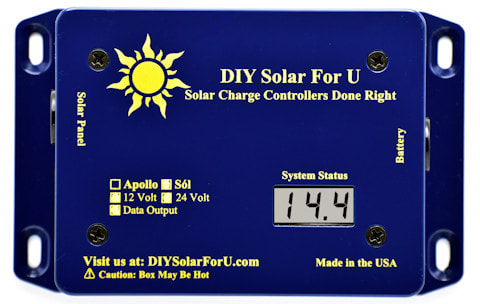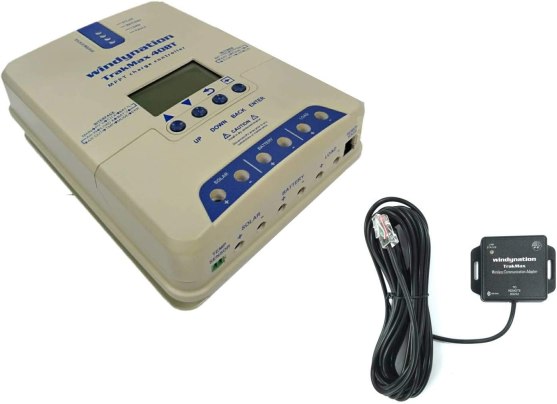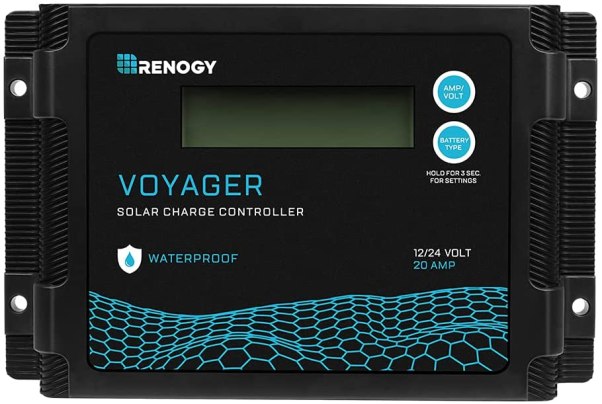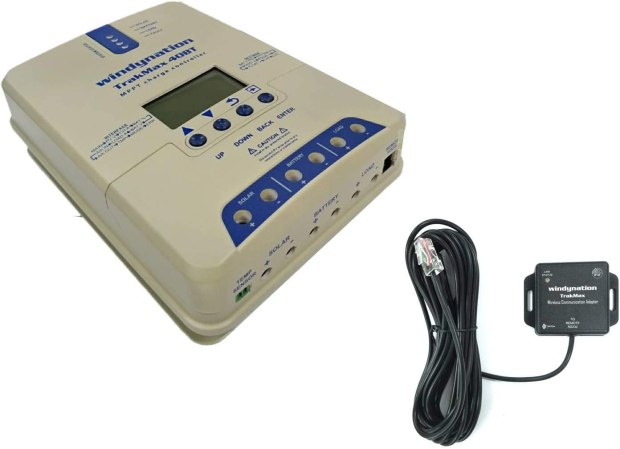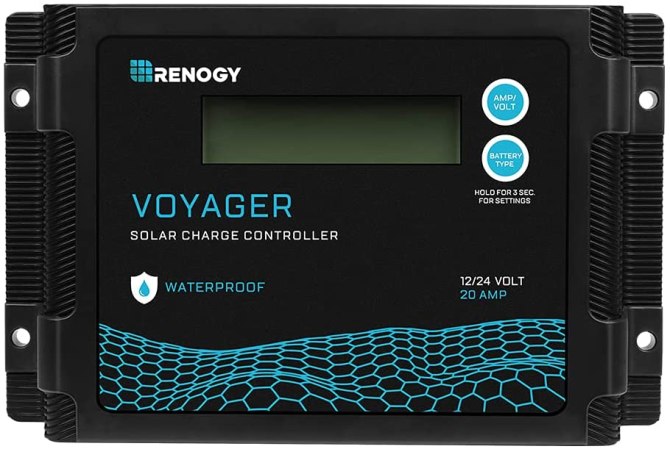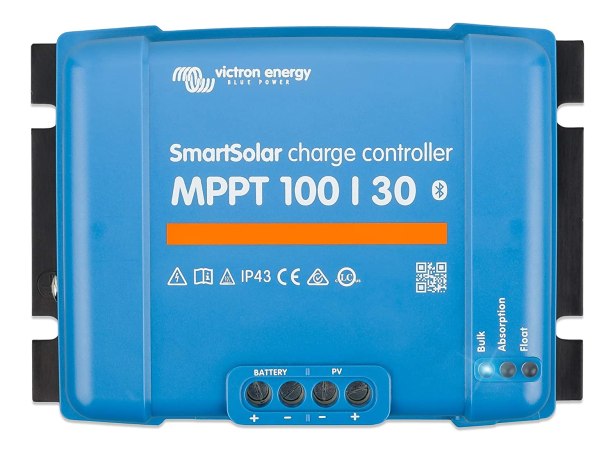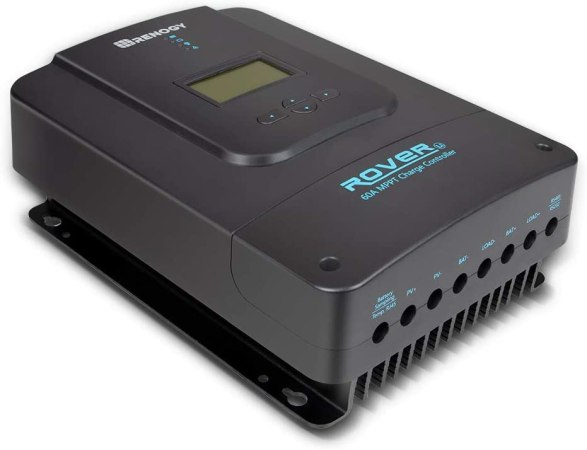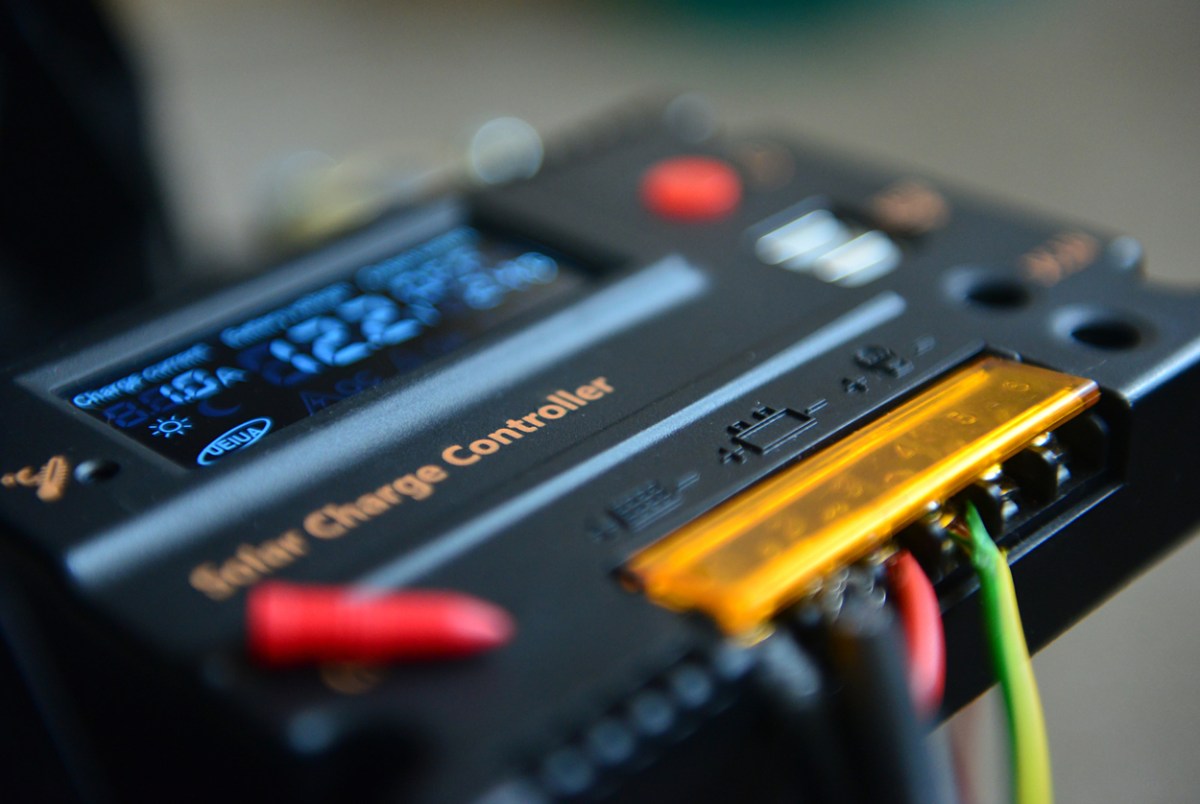
We may earn revenue from the products available on this page and participate in affiliate programs. Learn More ›
When installing off-grid solar power, a solar charge controller (or solar regulator) will function as the brain of your solar system. This necessary device connects the solar panels to the batteries, so as energy is produced from sunlight, a controller regulates this flow to prevent the panels from overcharging the batteries.
By monitoring high and variable voltage, the charge controller also protects your batteries from damage and even fires. Whether you’re installing solar power in your tiny home, shed or off-grid cabin, or are using it to power backyard lighting and water-pumping applications, a solar controller is an integral piece of your renewable energy system. A high-quality controller will help to maximize the efficiency of your panels so less energy is wasted.
We’ve sorted through many types of controllers that are available from top-rated companies, and present the best solar charge controllers to meet your system’s needs and your budget.
- BEST OVERALL: DIY Solar For U Sól Buck Boost 20 Amp MPPT
- BEST BANG FOR THE BUCK: WindyNation TrakMax 40 Amp MPPT
- BEST WATERPROOF: Renogy Voyager 10 Amp PWM
- BEST 30 AMP: Victron Energy SmartSolar 30 Amp MPPT
- BEST 60 AMP: Renogy Rover 60 Amp MPPT
What to Look For When Choosing the Best Solar Charge Controller
Off-grid solar power systems have four major components: a solar panel for collecting energy, a charge controller for regulating it, a battery for storage, and an inverter for use. If a solar controller is the missing part of this equation to install your system, there are several things to consider before purchasing one.
Size
The size of the solar charge controller will depend on how many watts you need to collect from the sun. To calculate the current capacity required, figure out how many amps your system normally produces and add 25 percent to account for temporary increases in current levels. When in doubt, it’s always better to go too big than too small. Using a solar charge controller with too few amps can negatively affect the system, but using a controller that’s larger than you need will not cause any issues.
Type
The charge controller’s technology is available in two options: pulse width modulation (PWM) and maximum power point tracker (MPPT). A PWM controller works by establishing a direct connection between the solar panels and the battery. On the other hand, MPPT controllers measure the solar panel’s voltage which is then down-converted to match the battery’s voltage, helping to increase the current.
Batteries
It’s important to consider what type of battery you’ll be charging. Whether it’s lead acid, sealed lead acid (AGM and Gel), or lithium-ion, you’ll want to ensure that the solar charge controller is compatible in order for the controller to function.
Added Features
There are several additional features that can enhance a solar controller and add convenience for the user. For example, multi-voltage function-enabled controllers let you adjust the charging voltage set point so the device operates more effectively. Or, if you’re willing to pay a little extra, some controllers have remote access so you can control the device from any location.
Load control is another important feature to look for, and refers to the ability to turn off your battery’s output when the charge controller senses the battery bank is too low. Most charge controllers have this function, so it’s mostly a matter of whether you want a controller with automatic load control or if you prefer to do it manually.
Lastly, it’s essential to monitor your system’s charge, current, voltage (including open-circuit voltage), and temperature, so choose a controller with an easy-to-read display.
Our Top Picks
When shopping for a solar charge controller, keep an eye out for the amperage rating, durable construction, warranty, type (PWM or MPPT), added benefits like digital display screens, and if the company offers resources to guide you with installation.
Best Overall
Sól Buck Boost 20 Amp MPPT
DIY Solar For U is a small, mom-and-pop business that delivers high-quality products with features not found in other solar charge controllers. Case in point: the global MPPT tracking in the Sol Buck Boost 20 Amp MPPT controller. This added feature finds the
global MPPT
operating point and then ignores the false maximum that is often triggered by partially-shaded panels, resulting in overall gains in the charge current. While some solar-powered systems struggle in cloudy weather, Sól still manages to extract power from low-light conditions, utilizing all available energy.
For maximum efficiency, it can both lower (buck) and raise (boost) solar voltage to battery voltage, increasing daily total energy input by 29 percent. This unique buck-boost technology allows the controller to operate where buck-only converters aren’t able to.
DIY Solar For U uses
automotive and/or military-grade materials wherever possible, and this
controller is made in the U.S., (with all parts sourced in the U.S.) with a
rugged cast aluminum enclosure.
It’s shipped in recycled materials and
includes a
5-year warranty.
Specs
- Type: 20amp MPPT
- Dimensions: 5.8 by 3.7 by 1.6 inches
- Weight: 1 pound
- Warranty: 5-year limited
Pros
- Made in the USA
- Designed for a service life of 40+ years
- Responsive customer service from knowledgeable people
- LCD display
- Small business
Cons
- Expensive
- Warranty doesn’t cover liquid spills (keep it dry)
Get the
Sól Buck Boost 20 Amp MPPT
at
Best Bang for the Buck
WindyNation TrakMax 40 Amp MPPT
If you’re looking for an MPPT controller at a bargain rate, the WindyNation TrakMax40 Amp controller
utilizes a software algorithm to maximize the energy production for your solar panels. Compatible with flooded lead acid, sealed lead acid (AGM), gel and lithium 12V or 24V batteries, this charge controller offers adjustable settings for fine-tuning to a specific battery manufacturer’s algorithms.
An LCD display provides all system information such as amps, volts, solar voltage, battery temperature and load control. The TrakMax
is made with virgin
and
features electronic protection against overvoltage, reverse polarity, overcurrent, excessive temperature and short circuits.
This fast sweeping controller optimizes the maximum power point in a short time period, allowing for efficiency of up to 99.9 percent.
Other accessories can be added separately like an
that can be mounted up to 20 feet from the controller and can be especially useful if your solar system is located in a difficult place to reach. Or, there’s a
wireless communication adapter
(Bluetooth) that can sync with a smartphone or tablet by downloading the free app.
Headquartered in California, Windy Nation was founded in 2009 to offer DIY solutions to solar installation. The company manufactures the TrakMax controller in China with parts sourced globally, and it’s shipped using packaging and printing made from recycled materials. If you have any questions about installation or other solar-related questions, WindyNation has several
available online.
Specs
- Type: 40 amp MPPT
- Dimensions: 9 by 6 by 4 inches
- Weight: 4.4 pounds
- Warranty: 1 year
Pros
- North American-based company
- Thorough, well-written product manual
- Fine-tuning to specific battery brand
- Uses recycled packaging materials
Cons
- Add-on module required for WiFi and Bluetooth
- Lower input 100v (voltage at open circuit)
- No end-of-life recycling or buyback options
Get the
WindyNation TrakMax 40 Amp MPPT
at
.
Best Waterproof
Renogy Voyager 10 Amp PWM
If you have a smaller budget but are looking for a solar controller for a simple off-grid solar system (like a sailboat or powerboat) the Renogy 10A Voyager is a great option with a simple interface that’s easy for beginners to use. However,
if you do need guidance on installation, Renogy has a number of resources on the website (but it’s worth noting that the company’s customer service is slow to respond to inquiries).
With a compact size, it can be installed almost anywhere, and to prevent damage from installation mistakes or system faults, the controller includes built-in, self-diagnostics and electronic protections.
Although PWM controllers are not as efficient as MPPT controllers, the Voyager does have a smart four-stage charging system (bulk, boost, float, and equalization) and temperature compensation. These features can help to increase battery life, and enhance the overall system performance. However, if you have a larger, more complicated system, this 10amp, PWM controller wouldn’t be the best choice.
Like similar Renogy controllers, it also offers protection against reverse polarity, overcharging, short-circuit, and reverse current and can be used on many types of batteries (including lithium). However, the Voyager has the added advantage of being iP67 waterproof rated, so it can be installed outdoors.
Renogy is headquartered in California and manufactures the controllers in China. The company performs life cycle assessments on products to determine the overall environmental impact of production, however, no end-of-product life disposal services are available for consumers.
Specs
- Type: 10amp PWM (20amp also available)
- Dimensions: 6.08 x 3.83 x 1.4 inches
- Weight: .55 pounds
- Warranty: 2 years
Pros
- Low cost
- Compatible with lithium batteries
- Waterproof
Cons
- (PWM) controllers are not as efficient as (MPPT) controllers
- Limited to smaller solar energy systems
- No USB ports
Get the
Renogy Voyager 10 Amp PWM
at
or
.
Check for a used Renogy Voyager on
.
Best 30 Amp
Victron Energy SmartSolar 30 Amp MPPT
Headquartered in the Netherlands
,
is considered a world leader in power electronics and specializes in manufacturing equipment required for off-grid and stand-alone power systems.
Victron has been building solar energy system components for 45 years and offers well-built quality devices using the latest technology.
The SmartSolar 30 Amp MPPT controller maximizes the energy harvested from the sun to quickly recharge a battery, while at the same time maintaining battery health and extending its life. The SmartSolar charge controller can also recharge depleted batteries with voltages as low as zero (as long as the cells aren’t damaged or permanently sulphated).
Victron has by far the most advanced system monitoring with an inbuilt Bluetooth connection offering easy programming and configuration, plus remote firmware updates which add extra features and options. The display-less controller design may not please all users, but the fast, accurate MPPT tracking, high build quality, and
options are stand-out features. In addition, the company offers
about MPPT controllers and other information about solar installation (free signup required).
Specs
- Size: 30amp MPPT
- Dimensions: 7.25 by 5 by 2.5 inches
- Weight: 2.82 pounds
- Warranty: 5 years
Pros
- Advanced monitoring app
- Built-in temperature sensor
- Super fast maximum power point tracking
Cons
- No display on unit, requires a smart device or separate display unit
- No load control
- Expensive
Get the
Victron Energy SmartSolar 30 Amp MPPT
at
.
Check for a refurbished Victron 30 AMP controller on
.
Best 60 Amp
Renogy Rover 60 Amp MPPT
Renogy is a leading manufacturer of solar panels, batteries, accessories and controllers and the 60 AMP Rover MPPT controller is a solid choice for larger off-grid systems. The versatile unit can be used with sealed lead acid batteries, Gel flooded and lithium batteries, and automatically detects
12V/24V/36V/48V DC systems, making it suitable
for RVs, commercial vehicles, boats or other systems.
In the event of an error, this MPPT controller has self-diagnosing capabilities in place to safeguard your system. The Renogy 60A Rover is an intelligent negative
, able to assess and protect against a number of potential problems such as battery overcharging (and over-discharging), reverse polarity, short-circuiting, overload, overheating and reverse current.
The device is made in China from a
shell and an aluminum alloy chassis with an integrated heat sink. It
has an easy-to-use LCD screen display and multiple LED indicators for displaying system operation information, customizable parameters and error codes. Renogy also offers a
(sold separately) that can be used in conjunction with the controller, allowing you to monitor the system’s performance from your phone.
Specs
- Type: 60amp MPPT
- Dimensions: 11.22 by 8.07 by 4 inches
- Weight: 9.53 pounds
- Warranty: 2 years
Pros
- Self-diagnostic for safety
- Suitable for any off-grid system
- Video tutorials offer ease of setup
- Compatible with 12V–48V DC input
- Company routinely participates in charitable initiatives
Cons
- Customer support is slow to respond
- App to adjust parameters can glitch
- Misreads battery voltage at times.
- Not waterproof (IP32 rating)
Get the
Renogy
Rover 60 Amp MPPT
at
or
.
Check for a refurbished Renogy Rover on
.
Our Verdict
The Sól Buck Boost 20 Amp MPPT is the perfect fit for a variety of solar energy system sizes and off-grid applications. It’s in a class all its own with buck-boost technology, top-notch customer service, and its rugged, built-to-last craftsmanship—and unlike most other charge controllers out there, it’s made in the USA. The only downside seems to be the price point, but with a service life expectancy of over 40 years, you should get your money’s worth. If your solar energy system (and budget) is smaller, the waterproof Renogy Voyager 10 Amp PWM is a great place to start and the company is based in the United States with lots of videos and diagrams to make installation easier.
How We Chose the Best Solar Charge Controllers
In determining the best solar charge controllers, we looked at more than 40 solar charge controllers from 20 different companies, factoring in customer reviews, efficiency, durable materials, and warranty repair programs from established brands.
Priority was given to North American-based companies offering accessible customer support and online resources, but we also paid particular attention to the quality of the build for longevity—better for your budget and the environment. We also searched for companies that offered buy-back or recycling programs to ensure a closed-loop production system, but couldn’t find any.
Most of our choices were MPPT controllers because they allow your solar panels to operate at an optimum power output voltage, improving their performance by as much as 30 percent (compared to PWM solar controllers).
FAQs
The following section aims to answer any remaining questions you may have about the best solar charger controllers. Look for the answers to your questions below.
Q: How much do solar charge controllers cost?
Solar charge controllers range from $15 up to $800, depending upon the features, power rating (from 10 amps to 100 amps), and type—with PWM being cheaper than MPPT controllers.
Q: How do I choose the right sized solar charge controller?
In selecting a controller, you must first determine how much power your panels will be producing before evaluating the size of the controller needed. To do this, add up the watts produced by your solar panels (if you have more than one) and divide by the type of voltage your system is using (usually 12, 24, or 48 volts) to get the amperage. However, it is advisable to add a cushion of 25 percent to this number so that you purchase a controller with a slightly higher amperage than estimated. It’s crucial to select the right size controller for your system or it will not function to its full potential. If you need help determining your energy needs, Renogy has a handy solar calculator, and in-depth, step-by-step guidance about sizing a controller for your solar system.
Q: Which is better PWM or MPPT?
Determining what type of solar controller is better depends on the size of your system and your budget. MPPT charge controllers are highly recommended for most large solar power systems. PWM charge controllers are often used in portable applications such as RVs, sailboats, or even conversion vans, as well as smaller immobile structures like a shed, tiny home or an off-grid cottage. However, they’re relatively inexpensive—perfect for upfront savings.
MPPT charge controllers deliver superior performance, with the only real downside being the additional cost compared to more basic options. However, MPPT controllers may provide more savings over the long term, depending on how frequently you use your system.
Q: How do I connect the solar charge controller to the inverter?
You should never plug a power inverter directly into a solar charge controller because they need a battery for reference to control the solar panel’s input. Connecting the controller and inverter directly without a battery can cause severe damage to the components of your solar energy system. To install the controller, you’ll need to connect a battery to the charge controller first and then connect a power inverter to the battery. If you’re a visual learner, this installation video explains how to set up a solar-powered system that uses a controller and an inverter.
Q: What should I do with my old solar controller?
If you no longer have a need for your old solar charge controller, it’s important that it doesn’t end up in a landfill. If it’s still in good working condition, you can offer it for sale on Ebay or a local Facebook Yard Sale page. If it cannot be repaired and is no longer functional, some solar manufacturers can assist with the disposal of the units, or you can check with companies that specialize in recycling solar equipment and electronics, such as Zeep Technology.
